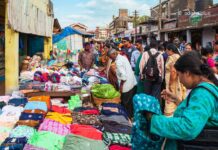Dr. Fakira Mohan Nahak
THE TELEVISION NEWS INDUSTRY IN ODISHA HAS GONE THROUGH A PROGRESSIVE JOURNEY IN THE PAST TWO DECADES. IN THIS SERIES DR. FAKIRA MOHAN NAHAK PRESENTS THE MEDIA HISTORY BLENDED WITH HIS CLOSE OBSERVATION ON THE FAST-CHANGING INDUSTRY.
Today every Tom, Dick and Harry is a Youtuber and YouTube has become a part of parcel of our life. But at that time, it was yet to be born. Pen drive was a distant dream and beyond anyone’s imagination.

Floppy disks were ruling the market and widely used for data transfer. The size of the digital photos was very small compared to the present age of multiple megapixels. CDs and DVDs were slowly gaining ground in the market. The tape was used on camera. There was still a long way to go before the card system arrived. Yes.. this was the story of the early 2000. We all were digitally challenged.
One fine day in 2005, ETV Odia News suddenly decided to make a story about the Rathyatra and the presence of Mahaprabhu Shree Jagannath outside Odisha. So the easiest available story for this was from West Bengal and Gujarat.

After the Odias, it’s the Bengalis and Gujaratis who treat Lord Jagannath as their near and dear one. The temple of Mahaprabhu Sree Jagannath are located in different cities of Gujarat like Porbandar, Ahmedabad, Gandhinagar, Vadodara, Surat, Patan, Mehsana, Anandand others.
In all of these places, Rathyatra is celebrated every year in great pomp and pleasure. Similarly, Mahesh RathYatrais the oldest in West Bengal. After Shrikshetra, the second oldest Rathyatra is celebrated in Mahesh.

Similarly, Rathyatras are celebrated in other places of West Bengal like Chandannagar, Chittaranjan, Darjeeling, Murshidabad, Bankura, Midnapore and Kolkata. While Maa Durga is the presiding deity of Bengal, they consider Shree Jagannath as their presiding Lord. According to the plan, there was no problem in getting stories about the Rathyatra from these two states as ETV has regional channels there.
But beyond that, ETV Odia had to rely on the ETV network to collect Rathyatra related stories from other states. When this initiative by ETV Odia was discussed in the meeting of the news coordinators, everyone else eagerly asked for a story about Shree Jagannath from their respective states. As a result, stories were collected from Assam, Manipur, Himachal Pradesh, Uttar Pradesh, Punjab, Madhya Pradesh, Bihar, Rajasthan, Chhattisgarh, Jharkhand, Andhra Pradesh, Tamil Nadu, Karnataka and Maharashtra.

ETV Oriya’s Delhi correspondent filed the local Rathyatra stories. This helped ETV Odia successfully telecast the stories related of RathYatra and Mahaprabhu Shree Jagannath across India.
But that was not the end of the story. The following year, before July 2006 Rathyatra, ETV started another initiative. This time the aim was to introduce the Rathyatra that happens outside India and the presence of Lord Jagannath abroad to the viewers of Odisha. In addition, the focus was to inform the audience about how Odia and non-Odia devotees of the Lord have been involved in the promotion of Shree Jagannath culture outside the country. The first attempt was made to establish contact with Odias living in the United States.

Communication was initiated with the Odisha Society of America (OSA) and the Jagannath Society of America (JSA) by the then News Coordinator Mr Nilambar Rath. Through email ETV wanted to convey the purpose of the initiative to them. The non-resident Odias living in the USA loved the concept.
In Nashville, the capital of the U.S. state of Tennessee, Lord Jagannath and his siblings were being worshipped in the local Hindu Temple.

Every year, the expatriate Odias living there celebrate the Rathyatra with great joy. But at the request of ETV that year, Prabir Dash, a senior member of the local Oriya organization, recorded a video of the Rathyatra with the technical assistance of others. The video was sent by courier to ETV Oriya headquarters. Ironically, at that time, the ETV Odia team could not anticipate an important technical obstacle. This is because the video colour encoding system in the US is NTSC (National Television Standards Committee) whereas in India the video encoding system was PAL (Phase Alternate Line).
So the first attempt was made to convert this video tape from the US to the Indian format. Despite all technical efforts, nothing fruitful came out by the team.Eventually, it was possible to convert the tape in a private studio in Hyderabad. But it was also a great learning experience. After receiving stories from the United States, a similar effort was made to collect stories from other parts of the world with the help of Odias.

Tathagata Sahu, based in Tokyo, Japan, helped ETV Odia in this regard. He helped to get visuals of how the Rathyatra was organized in a joint venture between the Odias and other expatriate Indians and the local people. In addition to that, with the help ISKCON (International Society for Krishna Consciousness), visuals of Rathyatra were collected from Russia, Australia, New Zealand, Brazil, Argentina, Mexico, Germany, England, etc. Not only abroad, but as in previous year, ETV collected footage of Rathyatras held in different parts of the country.

Finally, on July 6, 2006, a program titled “Desha Bideshare Jagannath” (Jagannath at home and abroad) was prepared narrating the worldwide presence of Mahaprabhu Shri Jagannath and his Rathyatra. It was first of its kind program in the history of Indian television. It was presented by Mrunalkanti Nanda. With the blessings of the Lord, the author was fortunate enough to be responsible for the production of the program.
The show got tremendous response from the viewers. The program also focused on the foreigners who came to India and fell in love with the Lord for a lifetime. One of such stories was that of Julian Parker, an American. He built a magnificent Shree Jagannath Temple in Bhadrak and dedicated himself to the Lord. Julian rechristened himself as Jahnav Nitai Das. Similarly, the program also featured the unadulterated love of African Americans for the Lord of the universe.

Interestingly, with mushrooming number of data transfer applications, it would not have been difficult at all to collect photographs and visuals from around the world today. At that time the biggest challenge was to plan and implement such a program in spite of all the technical adversity. But what is achieved despite all the adversity turns into a milestone in history and time.

ETV made another innovative attempt. At a time when sharing visuals on the Internet was a hard lesson, and appeared inappropriate from a commercial point of view, ETV Odia tried to upload audiovisual stories in the internet to be shown to viewers abroad. Audio visual stories with low resolution and duration of three and a half minutes were created and uploaded to the ETV website. As there was a fear that someone else would take the visuals from the website, no one agreed to take such a step. Yet it was a historic step.

Today, anyone who uploads any video on YouTube or other social media can reach millions of viewers in just a few moments. But at the time, it was a day dream. In such a situation, uploading videos and sharing website links with the audience was definitely a far-sighted step. In the years that followed, ETV kept on adding new stories to the program and did broadcast the program for about seven years.
(Dr. Fakira Mohan Nahak is a writer and former media professional. He is currently working as the Head of the Department of University Institute of Media Studies, Chandigarh University at Mohali, Punjab. Views are Personal)
Tags: #ETVIANs #TelevisionJourney #ETVOdia #LordJagannath #RathYatraLive #RathyatraCoverage #ISKCON #JagannathSocietyofAmerica #RathYatraHistory #LordJagannathStory #OSA #KrishnaConsciousness



























